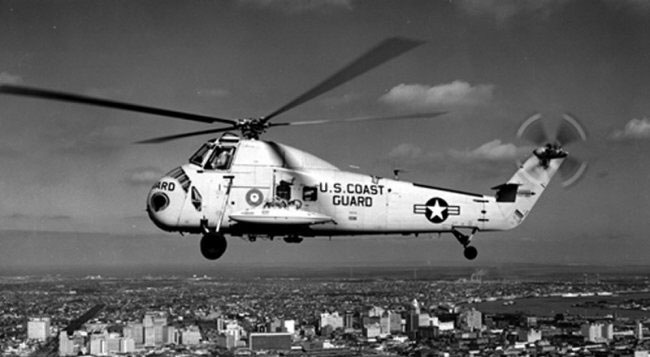
The H-34 started as a private Sikorsky Aircraft development, which the military ignored. However, it soon became a true workhorse in service with all branches of the U.S. armed forces, in addition to a host of foreign nations, and a variety of civil operators. The H-34 was also the final evolution of large piston-engine helicopters before the rise of turbine powered designs.
Early Sikorsky designs placed the large reciprocating engine behind the cabin. This had the effect of restricting the center-of-gravity of the helicopter to a very narrow range. Igor Sikorsky and his design team discovered that if they moved the engine to the front of the cabin, closer to the axis of the main rotor, the center-of-gravity envelope became much larger. This configuration required the relocation of the cockpit to a position on top of the engine. Sikorsky engineers inclined the engine at a 45-degree angle so that the drive shaft would not run through the main cabin, though this created a partition between the cockpit and main cabin. However, the addition of clamshell doors to the nose of the aircraft made maintenance access to the engine far simpler than it had ever been before.
A nine-cylinder air-cooled Wright R-1820-84 reciprocating engine powered the single-rotor H-34. The massive engine required an elaborate blower system to keep it cool. Shafts and gearboxes situated along the spine of the fuselage and a substantial tail pylon drove the tail rotor. The fuselage was all metal, principally magnesium alloy, for weight savings.
The SH-34s (HUS-1) were used predominantly for anti-submarine warfare operations and were equipped with dipping sonar to locate the enemy and/or torpedoes to home in on and destroy a submarine. They were fitted with automatic stabilization equipment.
The U. S. Coast Guard acquired six HUS-1Gs (H-34s) from Sikorsky in 1959 as a replacement for the HO4S-3G. The HUS-1G had a greater range, due in part to droppable fuel tanks, and a greater payload than the HO4S-3G. It was fully equipped for instrument flight, had upgraded electronics, a 600 pound capacity hoist and automatic stabilization equipment.
Three of the HUS-1Gs purchased were lost in accidents and the remaining three were transferred to Air America. The Coast Guard elected not to continue the purchase of the HUS-1G and instead participated with Sikorsky in the development of the Model S-62 for SAR use. The S-62 became the storied HH-52A amphibious helicopter.
| Specifications | |
| Manufacturer | Sikorsky |
| Designation | HUS-1G |
| Other Designations, if any: | S-58; HH-34 |
| Aircraft Type | Rescue helicopter |
| Rotor Diameter | 56′ |
| Blade Area | 2,460 sq. ft. |
| Height | 14′ 4″ |
| Length | 65′ |
| Top Speed | 122 mph |
| Cruising Speed | 97 mph |
| Sea Level Climb | 1,100 fpm |
| Range | 550 miles |
| Empty Weight | 7,900 lbs. |
| Gross Weight | 12,590 lbs. |
| Crew/passengers | 2 crew; 12-18 passengers; 5,100 lb. payload |
| Service Ceiling | 9,500 ft. |
| Engine | Wright R-1820-84 |

